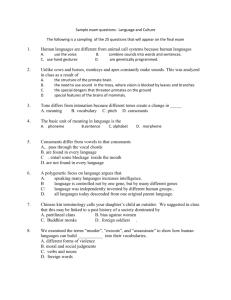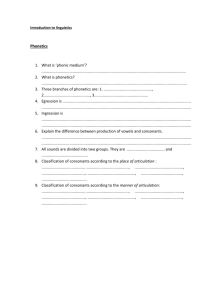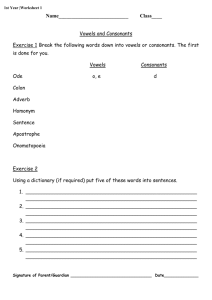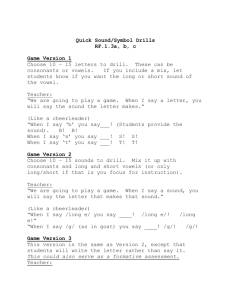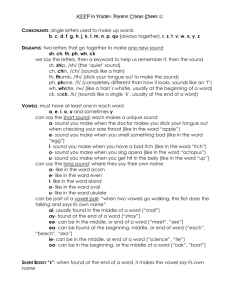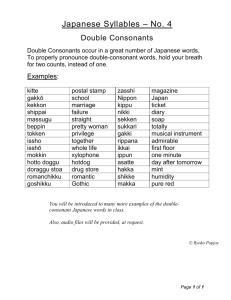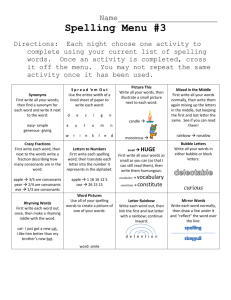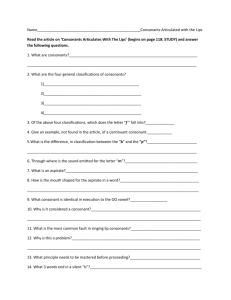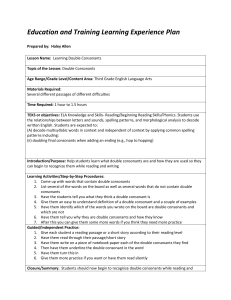English and Vietnamese consonants 1 HO CHI MINH UNIVERSITY
advertisement
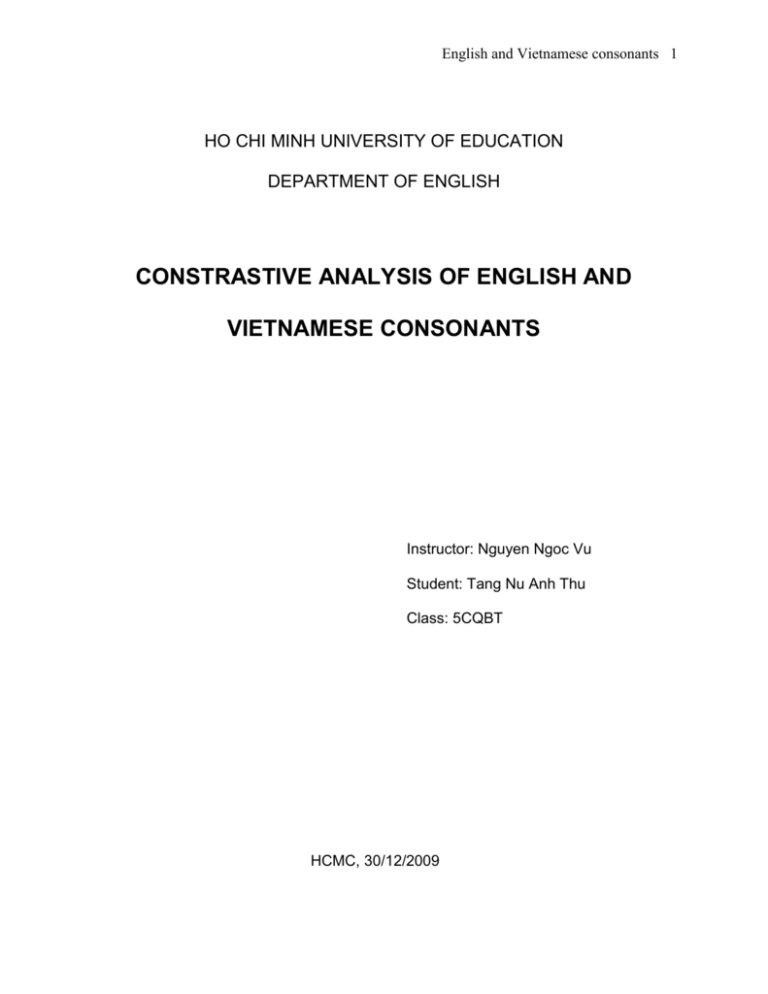
English and Vietnamese consonants 1 HO CHI MINH UNIVERSITY OF EDUCATION DEPARTMENT OF ENGLISH CONSTRASTIVE ANALYSIS OF ENGLISH AND VIETNAMESE CONSONANTS Instructor: Nguyen Ngoc Vu Student: Tang Nu Anh Thu Class: 5CQBT HCMC, 30/12/2009 English and Vietnamese consonants 2 Nowadays, English has become an international language that requires most people become fluent in using it. And a successful language learner is the person who can not only use the language but also can communicate in it. However, to most Vietnamese students, it is rather difficult to pronounce English words correctly. Therefore, they often have problems in communicating and understanding each other. As a result, learning to spell a word correctly is a must in order to be successful in communicating. In order to pronounce a word accurately, it is necessary to pronounce a sound correctly. Therefore, in this paper, I will focus on the English and Vietnamese consonant systems, and draw some similarities and differences which will be helpful for Vietnamese students in learning English. According to Oxford Advanced Learners’ Dictionary a consonant is “a speech sound made by completely or partly stopping the flow of air being breathed out through the mouth”. English and Vietnamese consonants 3 English consonants There are 24 consonants in English. They are classified according to 3 aspects: voicing, place of articulation and manner of articulation. Table 1: English consonants Manner of Place of articulation articulation Bilabial Labiodental Dental Alveolar Palato- Palatal Velar Glottal alveolar Plosive p b Fricative t d f v θ ð s z Affricate Nasal ∫ ʒ g h tʃ dʒ m Lateral Approximant k ŋ n l w r j (Peter Roach p 62) Place of articulation Here I take most of the definitions from Oxford Advanced Leaner’s Dictionary. Bilabials are consonants that are produced by using the two lips. English has 4 bilabial consonants. They are /p, b, m, w/. English and Vietnamese consonants 4 Labiodentals are consonants that are produced by “placing the top teeth against the bottom lip”. There are 2 labiodental sounds in English. They are /f, v/. Dentals are consonants that are articulated by placing the tongue between the teeth. English dental sounds include /, ð/. Alveolars are consonants that are produced “with the tongue touching the part of the mouth behind the upper front teeth”. There are 7 alveolar sounds in English. They are /t, d, s, z, n, l, r/. Palato-alveolars are consonants that “are produced by the contact of the front part of the tongue with the hard palate just behind the alveolar “ridge” according to the definition of palate- alveolar on the website http://www.unikassel.de. English palatoalveolars include 4 consonants /ʃ, ʒ, tʃ, dʒ/. Palatals are consonants produced by “raising the tongue body against the hard palate”. There is only 1 palatal sound. That is /j/. Velar are consonants made by “placing the back part of the tongue near or against the back part of the mouth -the soft palate”. There are 3 velar sounds. They are /k, g, ŋ /. Glottal are consonants articulated with the glottis. There is only 1 glottal sound in English. That is /h/. Manner of Articulation Plosive consonants are consonants made by “completely stopping the flow of air coming out of the mouth and then suddenly releasing it” (OALD). There are six plosive consonants in English. They are /p, b, t, d, k, g/. English and Vietnamese consonants 5 Fricative consonants are consonants articulated by forcing air through a “narrow space in the mouth with the lips, teeth or tongue in a particular position” (OALD). English fricatives include 9 consonants. They are /f, v, θ, ð, s, z, ∫, ʒ, h/. Affricates are consonants made up of a plosive followed immediately by a fricative (OALD). There are 2 affricate consonants. They are / tʃ, dʒ /. Nasal are consonants produced by “allowing the air to escape freely through the nose” (OALD). There are 3 nasal sounds. They are /m, n, ŋ Lateral are consonants “produced by placing a part of the tongue against the palate so that air flows around on both sides of the tongue” (OALD). There is only one lateral sound in English. That is /l/. Approximant are consonants made by bringing the parts of the mouth which produce speech close together but not actually touching (OALD). There are 3 approximant consonants /w, j, r/. Voicing Voicing also plays an important part in distinguishing sounds. The voiced consonants are those that are produced with the vibration of the vocal cord and the voiceless consonants are sounds pronounced without the vibration of the vocal cord. Voiceless consonants include /p, t, k, f, θ, s, ∫, h, tʃ/. Voiced consonants: /b, d, g, v, ð, z, ʒ, dʒ, m, n, l, w, r, j/. English and Vietnamese consonants 6 Table 2 : English consonants Ordinal Phonemes Letters Examples Ordinal Phonemes Letters Examples 01 p p pea, pin 13 b b bee, been 02 t t toe, tea 14 d d do, does 03 k c cap, car 15 g g gap, go 04 f f fat, fan 16 v v vat 05 θ th thing thank 17 ð th this, that 06 s s sip, sea 18 z z zip 07 ∫ sh ship, shape 19 ʒ 08 h h hat, hear 20 l l led 09 m m map, man 21 r r red 10 n n now, nap 22 j y yet 11 ng hang, hung 23 w w wet was 12 tʃ ch chin, Chinese 24 dʒ g gin measure English and Vietnamese consonants 7 Vietnamese consonants Vietnamese has 22 initial consonants and 8 final consonants. They are also classified according to place of articulation, manner of articulation and voicing. Table 3: Vietnamese initial sounds Place of articulation Manner of articulation Stop Labial t’ Aspirated unaspirated Alveolar Retroflex Palatal Velar Glottal voiceless voiced nasal fricative voiceless voiced lateral t ʈ c k ɲ ŋ b d m n f s ş x v z ʐ ɣ l Place of articulation Labial: Vietnamese has 5 labial consonants. They are /b, m, f, v/. Alveolar: There are 7 alveolar consonants in Vietnamese. They are ʔ h English and Vietnamese consonants 8 /t’, t, d, n, s, z, l/. Retroflex: Retroflex consonants includes 3 sounds /ʈ, ş, ʐ/. Palatal: There are 2 palatal sounds in Vietnamese. They are /c, ɲ/ Velar: Vietnamese velar consonants consist of 4 sounds. They are /k, ŋ, x, ɣ/ Glottal: There are 2 glottal consonants in Vietnamese. They are /ʔ, h/ Manner of articulation Vietnamese consonants are divided into two kinds in term of manner of articulation. Stop consonants include 12 sounds. They are /b, t’, t, d, ʈ, c, k, ʔ, m, n, ɲ, ŋ/ Fricative consonants include 10 sounds. They are /f, v, s, ş, ʐ, z, ɣ, h, l/ The stops There are also different kinds of stop consonants in Vietnamese Aspirated stop consonant includes /t’/. Voiceless unaspirated stop consonants include /t, ʈ, c, k, ʔ/. Voiced unaspirated stop consonants include /b, d, ɲ,ŋ/. Nasal stop consonants include /m, n/. The fricative Voiceless fricative consonants include /f, s, ş, x, h/. Voiced fricative consonants include /v, z, ʐ, ɣ/. Lateral fricative consonant includes /l/. English and Vietnamese consonants 9 Table 4: Vietnamese initial sounds Stt Âm Con chữ Ví dụ Stt Âm Con chữ Ví dụ 01 b b ba, bàn 12 ʈ tr trâu, trắng 02 m m mạ, mang 13 ş s sâu sắc 03 f ph phao, pha 14 ʐ r ráo riết 04 v v vào, việt 15 c ch chào chú 05 t’ th thầy, tha 16 ɲ nh nhà nho 06 t t tay, ta 17 k c, k, q co, quà, kẹo 07 d đ đi, đứng 18 ŋ ng, n, gh ngày, nghèo 08 n n nao, núng 19 x kh khó khăn 09 s x xanh, cây 20 ɣ g,gh gà, ghê 10 z d, gi dày, gian 21 ʔ (khuyết) 11 l l lo lắng 22 h h hay, ho English and Vietnamese consonants 10 Table 5: Vietnamese final consonants Manner of articulation Place of articulation Labial Alveolar Velar Noise consonant p t k Sonant nasal m n ŋ semi -consonant -w -j Place of articulation Labial sounds include /p, m, -w/. Alveolar sounds include /t, n,-j/. Velar sounds include /k, ŋ, -j/. Manner of articulation Vietnamese final consonants are also classified in terms of place of articulation and manner of articulation. Noise consonant sounds include /p, t, k/. Sonant sounds include 3 nasal consonants /m, n, ŋ/ and 2 semi- consonant sounds /-w, -j/. English and Vietnamese consonants 11 Table 6: Final consonants in Vietnamese Stt Âm Con chữ Ghi chú Ví dụ 01 -p p mọi trường hợp Tạp, lập, úp, mép 02 -t t mọi trường hợp Át, lét, nét, mét 03 -k ch Sau nguyên âm bổng i, , e Dịch, sách, lệch, đích c trong các trường hợp khác lấc cấc, mốc, thóc 04 -m m mọi trường hợp nam, àm, nhàm, tám 05 -n n mọi trường hợp nhân dân, tán, hạn 06 -ɲ nh sau âm bổng i, , e tính, tránh, sinh ,bệnh -ŋ ng trong các trường hợp khác trông, mong, đứng , đường -w o sau nguyên âm đơn dài tao, lao, vào bao u trong trường hợp khác đau, đầu, tiu nghỉu y sau nguyên âm ngắn 07 08 -j ,ă lấy, tày, bấy nay After analyzing the two consonant systems, I withdraw some similarities and differences between the two languages. Similarities In the initial sound system, Vietnamese and English both have these consonant sounds /b, d, k, m, n, f, v, s, z, h, l/. English and Vietnamese consonants 12 b (bố or bear) d (đi or dear) k (kẹo or keen) m (má or me) n (nôi or name) f (phở or five) v (và or visa) s (xin or send) z (gió or zero) h (hay or hand) l (lớp or lazy) In the final sound system, the two languages have these consonant sounds in common. p (lắp or hop) t (nét or meet) k (thóc or luck) m (tám or bomb) n (sen or sun) ŋ (đông or song) It would be better that we pay attention to these final sounds /p, t, k/ which are held in Vietnamese but released in English. Differences English and Vietnamese consonants 13 Though the two languages share some certain sounds, each language still has its own specific consonant. Sounds that just exist in Vietnamese and some common problems for English learners In the initial sounds, Vietnamese has the aspirated /t’/ in “thơ” which is similar to /t/ in English but actually, these consonants are quite different from each other. Therefore, English learners have the tendency to replace /t’/ by /θ/. The retroflex /ʈ/ in “trâu”, /ʐ/ in “rắn” and /ş/ in “sáng” in Vietnamese also cause difficulties for English students because there is no similar pronunciation in English. The voiceless unaspirated velar stop consonant in Vietnamese /x/ in “không” also makes English students confused with the aspirated /k/ in English. In addition, though the two languages share some consonants, some Vietnamese consonants can stand both of at the beginning and at the end of the words whereas English consonants can just be found at the other positions but not at the beginning of the words. For example sound /ŋ/ in “ngủ” can be the initial sound in Vietnamese but /ŋ/ just can play the part of the final sound in English such as /ŋ/ in “sing”. Similarly, /ɲ/ in “ngủ” is the initial Vietnamese sound but it /ɲ/ can just be found at the middle of the words such as in the word “Kenya” in English. Some other consonants that also cause problems for English students are the velar sound /ɣ/ in “gà” and the palatal sound /c/ in “chơi”. Sounds that just exist in English and some common problems for Vietnamese learners English and Vietnamese consonants 14 English also has a lot of sounds that cannot be found in Vietnamese. The approximant consonant /w/ and the aspirated /t/ in toy are distinctive sounds in English. However, the most difficult sounds that cause a lot of difficulties for most second languages learners including Vietnamese students are the four palato-alveolar sounds /∫/ in “shop”, /ʒ/ in “television”, /tʃ/ in “chain” and /dʒ/ in “judge” and the two dental fricatives /θ/ in “thing” and /ð/ in “this” . Besides that, English also has many consonants clusters at the beginning and at the end of the words. Therefore, Vietnamese students often left one or two sounds in the consonant clusters. For example, instead of pronouncing cold /kəuld/, Vietnamese students pronounce /kəul/. Vietnamese students also find hard in pronouncing the fricative / f, v, z /when these sounds occur at the end of words, so they often left out these sounds when pronouncing the words. For example, instead of pronouncing [li:f] in the word “leaf”, Vietnamese students tend to pronounce [li:] without the sound /f/ at the end. While English has voiced stop consonants at the end of the words such as /b, d, g/, there is no voiced stop consonants at the end of words in Vietnamese. Hence Vietnamese learners often confuse these sounds with the voiceless stop sounds /p t k/. That is the reason why they pronounce “bat” and “bad”, “pick” and “pig” the same. In conclusion, through a contrastive view into English and Vietnamese consonants, I would like to discuss some implication for teaching and learning at the high school in our country. Firstly it is necessary for teachers to help students to understand how to pronounce difficult consonant sounds in English. Teachers should explain clearly to English and Vietnamese consonants 15 their students about the features of consonants based on voicing, place of articulation and manner of articulation. Secondly, learners should be given more chances to practice pronunciation in and outside classrooms because practicing will make their pronunciation more accurately and naturally. Now, there are a lot of ways for students to practise pronunciation. A lot of books together with audio files such as Ship or Sheep, Tree or Three offer many exercises for students to improve their pronunciation. Besides that, internet is also a useful tool for learning pronunciation. Thirdly, teachers should spend time correcting students’ mispronunciation frequently so that students can realize their problems and pay more attention to the sounds that they often spell wrongly. Last but not least, students should be encouraged to talk to native speakers so that they are familiar with the real pronunciation outside the classrooms. Though becoming fluent in English may take a long time, I believe that if students try their best to practise, gradually they can improve the ability to speak and communicate in English. English and Vietnamese consonants 16 References Duong Thi Nu.(2009) Mistake or Vietnamese English. Hanoi. Vietnam National University Đoàn Thiện Thuật.(1957). Ngữ âm tiếng Việt. Hanoi. Hanoi National University Publisher. Hoang Thi Quynh Hoa (1965). A Phonological Contrastive Study of Vietnam and English. Texas. Texas Technological College. Le Quang Thiem.(2004).Ngôn ngữ học đối chiếu. Hanoi: Hanoi National Unniversity Publisher. Oxford Advanced Learner’s Dictionary.(2007).Oxford. Oxford University Press. Palato-alveolars. Dec 20, 2009, from http://www.unikassel.de/. Peter Roach.(1991).English phonetics and phonology. Cambridge: Cambridge University Press.
